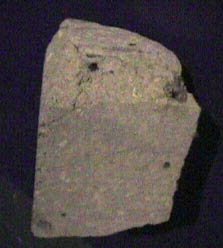Mars Meteorite ALH 84001
The meteorite designated ALH 84001 was found in Antarctica in 1984 by a member of the ANSMET meteor-collecting program of the U.S. Academy of Sciences, NASA, and the Smithsonian Institution. It was interesting enough at the time to be the first sample for the catalog for 1984. With a main rock body similar to lavas found just below the surface of the Earth, it nevertheless showed distinct differences leading to its identification as likely Martian in origin. The samarium-neodymium and rubidium-strontium ages of this meteorite were in the neighborhood of 4500 million years, much older than the other "Martian" meteorites. This led to its misclassification with the more abundant Antarctic meteorites that are presumably of asteroid belt origin. In 1994 it was retyped and attributed to martian origin. One of the criteria was the distribution of oxygen isotopes, very different from the meteorites of asteroid belt origin. Another distinction was a relatively short space exposure, as indicated by measurement of 3He, 21Ne, and 38Ar isotopic concentrations. These isotopes are produced by cosmic ray exposure in space and indicate a space exposure time in the range 12-17 million years. As another item of estimate chronology, a carbon-14 technique gives an estimate of 13,000 years for the time that ALH 84001 has been on the Earth's surface.
In 1996, ALH 84001 rose to prominence when a group of NASA scientists announced the discovery of possible fossils of microorganisms in this meteorite. This raised the possibility of confirming that life had existed on Mars. Subsequent studies failed to demonstrate anything that was a clear indication of life.
Reference: http://calspace.uscd.edu/Mars99/docs/library/science/mars_meteorites1.html
|
Index
Solar System Illustration
Solar System Concepts |
